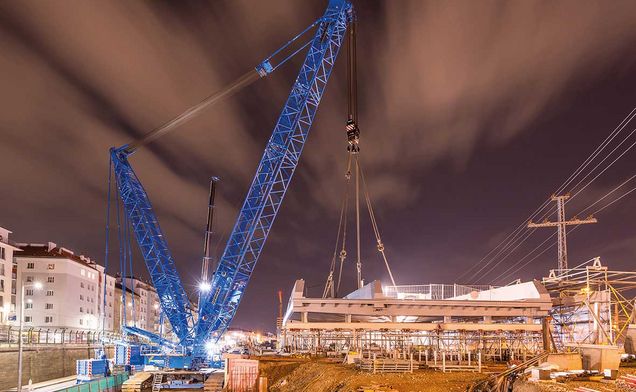1,000 tonnes of service weight to lift a bridge into place
April 20, 2017 | Markus Lackner
A 33-metre-long and 14-metre-wide bridge will in the future be used as a road, pedestrian and bicycle bridge to significantly improve the traffic network in the main station’s vicinity. The single-span steel trough bridge was delivered in four parts and completed on site. The architectural masterpiece weighs in at 245 tonnes.
Crawler crane with suspended ballast
38 lorry transports were required to remove the crawler crane with its maximum load capacity of 750 tonnes. “Our set-up time for the steel giant with 485 tonnes of ballast was a mere three days,” Michael Lehner from Felbermayr Transport and Lifting Technology reports. A mobile crane with a load capacity of 200 tons was used to assemble the crane on site. In the end, the crane was equipped with a 42-metre main boom and 31.5-metre derrick boom to optimally transfer the weights onto the suspended ballast.
To meet the static requirements to lift the bridge into place, compacted gravel soil was installed prior to the lifting procedure. “This was necessary to guarantee soil pressures of 40 tonnes per square metre and to not damage the asphalt,” Lehner explains. Furthermore, it allowed to balance the crane’s operating area which had a slight slope of some three per cent. Utilities such as sewage or power lines didn’t have to be taken into account.
Suspended transport with 240-tonne cargo
A time window of a mere five hours had been reserved for the lifting process itself. “We started at midnight, right after the last tramway had passed,” says Lehner and identifies the restricted space available as one of the greatest challenges. Once the team had removed a catenary, the bridge could be connected to the pulley. After that, the crane – carrying the bridge – rotated to the right by about 50 degrees. Later, the crawler crane had to be moved 20 metres to reach the bridge’s support points. Thanks to excellent weather and wind conditions, the crane operator had no problem following the spotter’s instructions for he could not see the bridge’s support points. Lehner comments that “wind speeds of more than 12 metres per second would have prevented us from lifting the bridge into place as the load could have started becoming unstable and could have endangered the operation.” However, thanks to absent wind (a rather unusual thing for Vienna), the 245-tonne bridge could be lifted into place without any safety concerns by the crawler crane weighing 755 tonnes. The following months will see the completion of necessary traffic infrastructure meaning that the bridge will most likely be opened for traffic at the end of this year. Vienna’s Municipal Department MA29 which is responsible for bridge construction and foundation engineering functioned as the client for this lifting project commissioned by Swietelsky.



